Chrome VI - Chromium VI
Contents
Chrom VI
The concentration of chemicals used in the production of leather and its effects on humans with acute chrome allergies seems to be well documented. Often, these reports highlight the exceeding limits of chromium compounds contained in the many items made using leather. These are usually substances which do not not necessarily exist in chrome tanning processes, however, they may arise depending on the method and the materials used.
However the main point that is often forgotten about, relates to the main chemical (Chromium III) which is used for tanning majority of leather around the world. Chromium III is not harmful to health and it is commonly found in most animal or plant tissue. The use of Chromium III in dietary supplements and its proposed benefits has led to controversial results but it is also clear that moderate intake of Chromium III does not pose any significant risk to human health. Damage to human health caused directly from chromium III have not been observed in tanners who work with this chemical on an almost daily basis, and also amongst consumers and users of finished products who wear and use this in their everyday lives. Majority of leather shoes made in the world are chrome tanned leather and there has hardly been any cases of customer complaints which can be traced back directly due to the use of Chromium III as a tanning agent. Chromium III is not considered toxic but because Chrome sounds as a harmful chemical element and many people suffer from "chrome nickel allergies", it is easy to derive a negative connotation from it.
However, Chromium VI, is toxic and carcinogenic and may exist in leathers under certain conditions. This is a phenomenon that we must not play down, but there are hardly any cases known, where actual damage to people is caused by contact to leather. Strict limits have been laid down in the use of this chemical and it is well controlled within the leather industry, therefore any issues caused by it is almost always traced back to excessive use. However, it is important to note that there haven’t been any notable cases where this has led to damage to the customer.
Chromium (III) oxide in powder form.
Chromium VI compounds also known as Hexavalent Chromium are chemical compounds that contain chromium in an oxidised state. Unlike the relatively unharmful compounds of Chromium III, Chromium VI compounds are are toxic when inhaled in higher doses and its toxicity can cause acute long term health defects. However, it must be remembered that Chromium VI has no tanning properties.
Micrograph of chromium VI compounds - chromium VI
Work gloves in Germany are allowed to have up to three milligrams releasable chromium (VI) per kilogram leather. This is also the technical detection limit and corresponds to the industry standard DIN EN ISO 17075 of February 2008. In the test according to this standard, the chromium (VI) content is detected with Diphenylcarbazide (DPC), which originates a pink color complex.
In the REACH Regulation (EC) No 1907/2006, entry 47 in Annex XVII, column 2, valid from 05.01.2015, the restriction of chromium (VI) compounds in leather products is newly regulated. In Leather products that come into contact with skin should not be placed on the market, if chromium (VI) content is equal to or more than 3 ppm (parts per million) (also referred to as 3.0 mg/kg)of the total dry weight of the leather. This also applies to products containing leather parts that come in contact with skin. An exception applies to used leather objects that were owned by consumers before 05/01/2015. They may continue to be treated as "second-hand". The previous rules only applied to leather that "permanently" came into contact with the skin. However, almost any leather produced can come in direct contact with skin (Car leather, furniture leather, handbag leather, clothing leather, shoe leather), therefore this rule applies to almost all leather.
The current maximum allowable amount of 3 ppm (0.0003 percent by weight) based on the dry weight of the leather is the lowest possible amount of Chromium VI that can be detected by any instrument. Thus, it always comes back to different measurement results for the same samples. To improve the correctness of the results, the leather industry is looking for better methods of measurement.
Tests on chromium (VI)
Between 2000 and 2006, the investigating authorities of the federal states in Germany analyzed chromium VI content in about 850 leather samples (etc. gloves, shoes, bracelets). Approximately one in two of these samples were found to contain the harmful chemical. Of the ones identified, in every sixth sample a proportion of 10 milligrams of chromium (VI) was present in per kilogram of leather. Already by concentrations above 5 milligrams per kilogram but there is a danger of creeping immune sensitization that can lead to a specific allergy - especially in people already prone to eczema. Another risk factor is the contact of chromatepolluted leather goods with non-intact skin (roughened, small injuries).
In July 2013, 20 children's shoes, 20 work gloves and 20 watchbands have been tested. In its infancy exceeded 4 the limit at the gloves 6 and the watch straps 2. These products were in the same price range ad the average of all tested products. With 62 mg / kg, a glove was a particularly polluted.
Dangerous products containing too high chromium-VI-proportion are listed the RAPEX sytem ( The rapid alert system for non-food dangerous products (RAPEX)) The authorities may decide to take appropriate measures depending on the content of Chromium VI in the product. For instance, the amount of Chromium VI in the leather hood of a children’s jacket was estimated to be 37.3mg/kg. The authorities have imposed a direct ban on marketing of the product and other measures like withdrawal of the product altogether.
With high-quality leather products no problems with chromium VI were registered in recent years.
Chromium VI in the press
Many reports of chromium VI exceedances have been published in the press. However, none of the reports provide any details of damages or allergies caused.
Chromium VI allergy
If allergic, even the slightest amount of chromate is enough to elicit inflammatory skin reactions such as swelling, blisters, itchy red spots and desquamation. These skin reactions are initially limited to the direct contact points for chromate leather, but can, in extreme cases spread throughout the body, if the contact is not set.
Cures do not exist and the allergy persists for life. For anyone affected or concerned with such allergies, it is advisable to avoid chrome-tanned leather altogether and only purchase leather articles with pure vegetable-tanned leather. However, it must be noted that some vegetable tanned leather are also combined with chrome tanning. It is therefore important to only buy, pure vegetable tanned leather.
The avoidance of chromium VI compounds in leather
It is now well understood how chromium-VI compounds are formed and that they can be avoided consistently by following the appropriate methods and using the correct products. Chinese scientists have shown that leather containing high proportions of unsaturated fatty acids result in the formation of chromium VI. Irregularities in the tanning process, certain additives combined with the presence of chromium III compounds can result in the information of Chromium VI compounds. Meanwhile, scientists are targeting chrome tanning agents, which are provided with additives that counteract the emergence of Chromium VI. However, these materials are expensive, and the consumer should not assume that all imported goods are safe. In such cases, the customer can only rely on commitments of manufacturers who undergo voluntary inspections of their batches and can prove it by having their goods tested by reputable independent testing institutes.
A study in 2011 found that the use of heat and adhesives in shoe production promotes the formation of chromium (VI). Leather with a higher tannin chromium (III) proportion are more prone to the formation of chromium (VI) as a leather with a lower chromium (III) proportion. In this study the reducing agent ascorbic acid, and Hexagon were tested. This could reduce the chromium VI content.
The complexity of the development opportunities of chromium VI, results from the following list of recommendations for tanneries:
- The raw hides must be thoroughly degreased. In particular, the fattier lambskin and pigskin are more vulnerable than cowhide.
- Bleach should preferably not be used and in any case after tanning.
- The chemicals used for tanning must be chromium-VI-free. The manufacturer must certify that the chemicals are chromium-VI-free and the storage conditions must be perfect.
- The pH must be closely monitored in the neutralisation process.
- Wet blue must be adequately preserved.
- To protect against oxidation, 1-3% vegetable tannins must be added in the retanning stage.
- Oxidation-stable fatliquors to be used instead of unsaturated fatliquor.
- The used pigments are to be chromium-free.
- Ammonia or ammonium-containing chemicals (among other things) should be dispensed in the neutralization or dyeing stages.
- The finish should be terminated at low pH values.
- At the operation step of the finish high temperatures should be avoided.
- An additional wash cycle should be implemented.
- All equipment, machinery and liquids used in the production process must be free of contamination.
- Mold growth should be excluded in the whole process.
- Too low humidity during storage greatly accelerates the chromium (VI) formation.
- If stored for a long duration, the leather should be tested for chromium VI.
Emergence risks of chromium (VI), exists in the production of leather, in the processing of leather and in the storage of the leather. So in the whole chain from production to end of life of the product. must be closely monitored. Water-repellent leather, leather in darker shades and vegetable retanned leather are less likely to result in formation of chromium (VI) -in comparison to split leather or bright leather.
How to test chromium VI content
Anyone who wishes to check the chromium VI content of leather, should contact national leather examination laboratories. The cost of such a test is indeed affordable, but a minimum of about 10 grams (about 10 x 10 centimeters of typical cow hide for cars or furniture) of leather is required to carry out the tests. Testing leather garments, leather shoes and other smaller objects however may mean the destruction of the entire test object. In car seats and furniture, it is easy to remove 10 grams from concealed areas. Therefore, such tests usually are performed by commercial customers who can check their goods before they are marketed.
Quick Test chromium VI content
A study of rapid tests in 2016 showed that they provide too many false results due to the complexity of the test materials and the objects to be scanned. Estimated future chemistry is partially highly corrosive, the durability of the DPC reagent is of very short duration, the study is carried out only on the surface of the leather which result in falsified results, dyes in leather can interfere with the visibility of the pink colour (Chromium VI) and the chemistry used can potentially destroy the material. This concludes that a quick test is not on par with professional laboratory tests.
Chromium VI in tanning history
The report of tanner Andreas Ollert from 1953, who today (2014) is still alive and very healthy: When I learned my profession, Chromium (III) was not available. We had to produce it from Chromium (VI).
This work was popular with the apprentices. After preparing the brotz, there were only monitoring tasks. You have been freed from the very heavy physical work. The chromium VI was delivered as a light orange salt in wooden barrels. It fascinated me. I sank my arms up to the elbows into it. No idea how much of the "poison" was under my fingernails when I have eaten later my breakfast bread later. At that times no regulations existed. I was only wearing glasses because of the sulfuric acid.
Chromium VI
Additional information







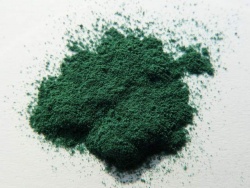
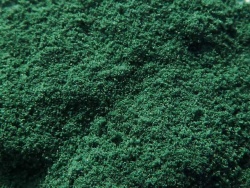
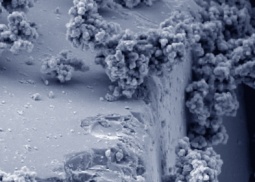
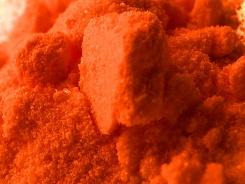
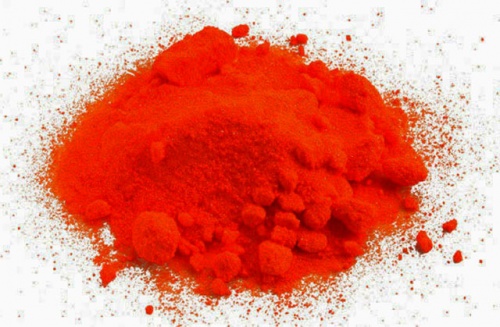

 a kotori web solution
a kotori web solution